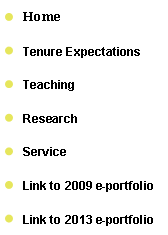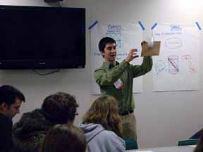


|
EDUC 384: Secondary Math Methods |
|
This particular course has changed substantially since I first taught it in the spring of 2009. The 2009 e-portfolio established the “soul” of the course (our engagement with Bob Moses’ powerful ideas about mathematics education and civil rights), and I’m proud to say that the soul is still intact. The “body” of the course (its outward appearance) has beefed up quite a bit since 2009. I introduced an embedded clinical teaching experience, modeled after the kindergarten work in the elementary methods course, in the spring of 2010. Working in collaboration with the 7th grade math teacher at Jordan Catholic School, my students teach weekly lessons catered to the identified learning needs of Jordan’s 7th graders. Hence, my students are able to apply the teaching methodologies they learn in my course directly in “real life” teaching situations. The Jordan Teaching Labs work sample provides the assignment description of the labs, full samples of Augie student work in the labs (e.g., all lesson plans and other materials produced over the entire term), and the feedback I provided to the sample students during the term. As noted on pages 9-10 of my 2011 case-making statement, the feedback I received from the National Council of Teachers of Mathematics (NCTM) as part of the Education Department’s accreditation review prompted me to make even more changes to EDUC 384 for the spring term of 2011. In essence, these changes involved making more explicit connections between my course and the NCTM standards. These connections are represented most clearly via the Teaching Portfolio assignment. With this assignment, students are required to demonstrate how their body of work in EDUC 384 aligns to NCTM standards. That is, for each standard the student is required to explain how he or she adhered to that standard and also provide documentary evidence supporting this adherence. My spring 2011 students built these Teaching Portfolios electronically using Google sites. The Teaching Portfolio work sample includes the assignment description, links to two of the student-built e-portfolios, and three examples of the evaluative feedback and scoring I provided for a relatively strong, average, and weak portfolio. (Note that EDUC 384 had only 5 students in spring 2011. The two student-built e-portfolios include the creators’ names and therefore I have NOT provided the evaluative feedback associated with those two portfolios in order to protect the students’ privacy. The three scoring rubrics you will see were given to the other three students. Reviewers will not be able to see the original work of these three students or their names, but will be able to see how I provided feedback to students and how I differentiated between weak, average and strong work.) |

|
Mike Egan Assistant Professor of Education |

|
EDUC 384 student Brian Green presents to an audience of practicing teachers at the 2011 Western Illinois University Mathematics Teachers Conference in Macomb. The WIU conference presentation was one of the required assignments for EDUC 384 in the spring of 2011. |

|
Course Documents
Syllabi
Student Work Samples
Student Ratings of Instruction Spring 2010 Quantitative Summary Spring 2011 IDEA Quantitative Summary Spring 2011 Complete IDEA Forms
|